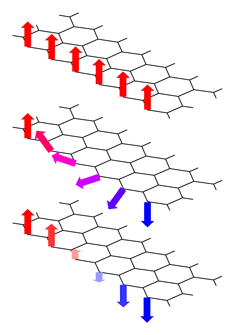Graphene Holds Promise for Spintronics

Graphene is a nanomaterial which combines a very simple atomic structure with intriguingly complex and largely unexplored physics. Since its first isolation about four years ago, researchers suggest a large number of applications for this material in anticipation of future technological innovations. Specifically, graphene is considered as a potential candidate for replacing silicon in future electronic devices.
Theoretical physicists from the Swiss Federal Institute of Technology in Lausanne (EPFL) and Radboud University of Nijmegen (The Netherlands) performed a virtual crash-test of graphene as a material for future spintronic devices. In particular, a possible components of future computers. The material successfully passed the test, albeit with some reservations. The results have been published in the February 1, 2008, issue of Physical Review Letters.
Current technology uses the charge of electrons to operate information in electronic devices. As an alternative, one can use intrinsic spin of electrons for this purpose. Electronic devices making use of electron spin has acquired the term, spintronic devices. Several types of such devices have already found their way into the market-place in high-capacity hard drives. Recently it was introduced in a non-volatile magnetic random access memory (MRAM). Further, replacement of charge-based devices by the spintronic components promises faster computers and less energy consumption.
While spintronics requires magnetic materials, graphene itself is non-magnetic. However, when a single graphene layer is cut properly, ( e.g. using lithographic techniques widely used in the current semiconductor technology), electron spins are theoretically predicted to align at the edges of graphene. This amazing property of graphene has attracted considerable attention by theoretical researchers giving rise to new designs of spintronic devices.
However, there is a gap between the theoretical models and the actual prototypes of such devices. The problem lies in the fact that such edge spins form a truly one-dimensional system. It is known that one-dimensional systems are very sensitive to thermal disorder which destroys the perfect arrangement of spins. Strictly speaking, a one-dimensional magnet cannot maintain the perfect alignment of magnetism at a temperature above absolute zero. This entropy-driven behavior is in sharp contrast to bulk materials (such as iron), which is able to keep the perfect order of electron spins below certain temperatures, (Curie temperature). This factor allows using bulk materials as permanent magnets. An important component of modern technology. On graphene edges, the order on spins can exist only within a certain range which limits the dimensions of spintronic devices.
Researchers from Switzerland and Netherlands performed, "computer-time-demanding first principles calculations," in order establish the range of magnetic order at graphene edges. At room temperature, the range or spin correlation length, was found to be around 1 nanometer which limits device dimensions to several nanometers. This result may first look rather disappointing. This is about one order of magnitude below the length scales of the present-day semiconductor manufacturing processes. Nevertheless, graphene performed better than any other material when it came to one-dimension and room temperature factors. In other words, graphene is the best performer on the nanoscale.
"We are very optimistic about these results," says Oleg Yazyev, Postdoctoral Researcher at the Swiss Federal Institute of Technology. "One can now devise different ways of increasing the spin correlation length on graphene edges." Dr.Yazyev further stated, " For instance, we are now looking for an appropriate chemical modification of graphene edges in order to further extend the length-scale limits. This is only beginning of an interesting direction of research".
Citation: ‘Magnetic Correlations at Graphene Edges: Basis for Novel Spintronics Devices’, Physical Review Letters 100, 047209 (2008)
[web-link: link.aps.org/abstract/PRL/v100/e047209 ]
Source: EPFL





















